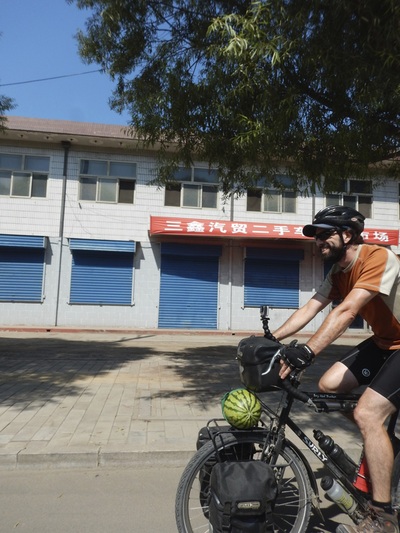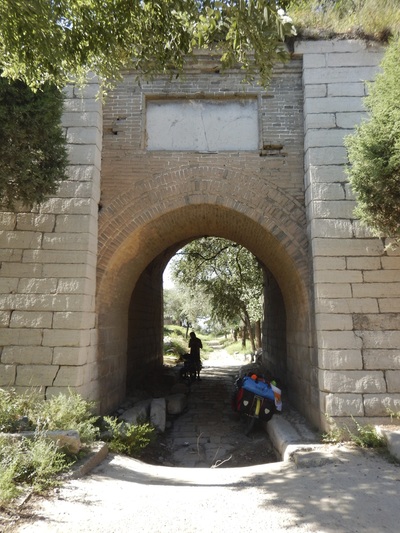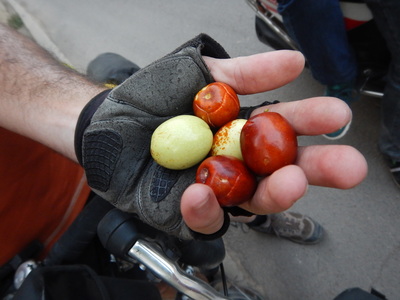The next morning, we went all out at the breakfast buffet, an aspect of travel we had not enjoyed since beginning in Beijing. An added bonus was the rooftop view of the beautiful mountains surrounding Lhasa. Then we met our mandatory guide, Tenzin, a friendly but reserved Tibetan from a village about 100 kilometers outside of Lhasa. We got right down to business by visiting Lhasa's most famous icon, the majestic Potala Palace. It is the traditional residence of the Dalai Lama, serving as the center of both the Tibetan Buddhist religion and government until the Chinese invasion in 1951. Since it is a such a popular sight and we were unfortunately touring at the height of peak season, we had just an hour to absorb the interior of the significant building. Then again, the Chinese officials only allow visitation to a small percentage of the complex, and everyone is constantly reminded of who is in charge with China's flag flying atop the highest point of the palace. Our guidebook astutely points out the "modern irony that the Potala now hums with large numbers of domestic tourists staring with wonder at the building that the generation before tried to destroy."
Next we toured the Jokhang Palace in the heart of old town, seeing similar deities to those depicted in the various murals and statues in the Potala. However, given the multitudes of gods and the many forms they can take, the repetition was quite welcome! From the rooftop, we were fascinated by the constant stream of Buddhist pilgrims crossing the Barkhor Square, walking a circuit, always clockwise, around the Jokhang Palace and other temples nearby in what is known as a kora. After encouraging us to join the traditionally-clad folks, some local and others from far away, our guide bid us farewell for the day.
We did not get far along the kora before a young woman in a knee-length lime green down jacket struck up conversation with us in limited English. As she paced with us, she thrust her prayer wheel at me so I could literally give it a whirl. The hefty wooden handle had been polished by her hands gripping it during countless rotations of the attached metal cylinder stuffed with mantras--written prayers--inside. The spinning activates the mantras and thus the Buddhist gains merit. The subtle gyration of the wrist to keep prayer wheel turning looks so engrained in the elderly Tibetans that it reminds me of young girls who read entire books while hula hooping.
When hunger got the better of us, we parted ways with our kora friend and found another yummy momo lunch at a simple little place down a side street leading to the Muslim neighborhood. Then our explorations took us beyond old town, where we loosely followed a suggested walking tour in our guidebook that led us to some less famous, but still captivating, religious sites. On the way to a monastery with deities carved in relief on cave walls, we watched mani stone carvers precisely chiseling beautiful prayer inscriptions in artistic Tibetan script. We took a few wrong turns, but eventually found an immense pyramidal chorten made entirely out of the carved mani stones tucked away behind a hill overlooking the city. Just before sunset, we paid a nominal entrance fee to fight our way through throngs of tripod-toting Chinese in order to snap a picture of the Potala bathed in golden light from a famous vantage point that eliminates most elements of modernity in the photo's composition. Exhausted from at least eight miles worth of both aimed and aimless wandering, we opted for the novelty of a yak meat burger and yak cheese pizza at a well-regarded touristy place. This was an unfortunate reminder that some things are just not meant to be.
The next day was spent visiting two important monasteries on the outskirts of Lhasa. In the morning, we went to Drepung Monastery where we first climbed up to a huge wall where a thangka (religious scroll painting) of the same size is unfurled during festival time. Tenzin then toured us through the main assembly hall, smaller side chapels, and other aspects of monastery life such as a kitchen designed to produce simple food for a large population of monks. Of course, the Chinese government now strictly controls the number of monks allowed to reside in any given monastery, so the sprawling complex with several different colleges felt like a remnant of a more bustling vibrant time. We requested some extra time there in order to walk the kora around the perimeter of the monastery. Between spats of rain, we witnessed pilgrims drinking from a sacred spring and making offerings at small shrines along the boulder strewn path. One man was engaging in an amazing act of devotion by fully prostrating on the ground, stepping forward only the length of his body to prostrate again, and repeating this for the duration of the route. We came across his prostration marks in the gravel long before we caught up to him; the shape of the consistent pattern was similar tracks left by a nesting sea turtle on a sandy beach.
In the afternoon, we went to the comparatively bustling Sera monastery, with more monks, devotees, and tourists than Drepung. In particular abundance were babies and toddlers with a black smudge on their noses, a blessing from visiting the chapel of a specific protector deity there. A room containing several colorful and detailed sand mandalas was mesmerizing, but the true highlight was watching novice monks engaged in lively debate in a shady courtyard. Each pair was free to debate their own chosen topic, with one seated cross-legged and the other standing over him, emphasizing each point with a dramatic slap of his hands.
We spent the evening on our own with more street wandering, scoping restaurants, and eventually settling on a "classic" Nepali-run place that has developed a loyal following among Lhasa veterans over the years. Here we sampled some tart but tasty homemade chang, the closest thing to craft beer within a few thousand miles of us (we presume).
As we ate breakfast on the rooftop the next morning, we noted the presence of some dark grey storm clouds closing in on the peaks, but in the moment did not think so much of it. We began the drive toward Namtso, one of three major holy lakes in the TAR, on a road that parallels the train tracks we arrived on. We left late morning and the going was slow. Our driver, who had pulled some crazy moves in the city in a race against we're not sure who or what, was now so leisurely on a straight open road that he repeatedly began to doze off! Tenzin explained that the government recently imposed a system of driving time allocations between checkpoints to control speed. This was in response to two majorly fatal accidents involving tourist vehicles earlier this summer. I actually agree that a measure of control makes sense to curb the insane driving habits of the people on this continent. However, the time allocations from point A to point B were so conservative that a cluster of vehicles was inevitably pulled over on the side of the road just prior to the control station, killing time until their time stamp from the previous checkpoint was no longer incriminating.
At one of our many time-killing rest stops, our guide learned from another group that the road going over the pass to Namtso was closed due to new snowfall. They had turned back and were returning to Lhasa. At first this news came as a surprise, but then those distant but foreboding clouds of the morning suddenly popped into our consciousness. Fortunately, our guide was game to keep going and see the situation for ourselves.
Skipping our lunch stop, we reached the national park entrance station and bought non-refundable tickets despite the ridiculous fact that they could not inform us whether the troublesome pass that lay ahead had reopened or not. Luck was on our side though, as it appeared the first traffic of the day had been let through just as we were approaching. The accumulation of fresh snow was formidable, but the sky had cleared and the sun was shining down the scenic valley. We were delayed further by a truck that got stuck on an incline, but once past the traffic jam, our intense driver made up for it without any time checks to hold him back. We arrived to the ramshackle town on the Tashido peninsula of the lake late in the afternoon, but especially grateful that our uncertain day in the van had not been for naught.
After wolfing down a very late lunch in our charming lodge, Namtso Holy Lake Guesthouse, we set out to walk the kora around the bluffs of the peninsula. The natural beauty was astounding and made it easy to understand why this saltwater expanse is considered sacred. We passed by concentrations of prayer flags and cairns, as well as mantras painted on rocks, and revered white yaks. While I paused to take a photo, Matt glanced back and commanded me, "Don't move!" Then I heard galloping hooves approaching quickly but was too shocked to look behind me. When the sound stopped close by and I had not been trampled, I turned around expecting to see a yak, and instead saw a hilariously scrawny goat lowering its criss-crossed horns to the dog that had harassed it. Perhaps the goat ran towards us as a measure of protection because it then followed us like it was our pet all the way back to our lodging!
As the sun hovered close to the mountainous horizon, the temperature dropped quickly. We put on a few more layers and this time headed up the bluffs to a sunset viewpoint. In keeping with tradition of our travels, we managed to just miss the actual sunset, but the benefit was that we had the promontory to ourselves as we watched bright stars pop out, then walked down the ridge lit by the moon. A late noodle soup dinner and chilly room where we quickly jumped into the sleeping bag completed the day.
In a rare bout of motivation to get up early to make up for the missed sunset, we climbed back up the bluffs in the wee morning hours and shivered there until the sun made its way over the surrounding mountains, a show of gradual color transformation of the landscape. After warming up during a typical breakfast of tsampa, roasted barley flour with just a touch of moisture, we poked our heads into the local monastery. Then we simply sat on the gravelly beach and watched the waves lapping the shore, noting that it had been far too long since we had been surrounded by such stunning natural beauty! In full disclosure, I will admit that I could not resist the horribly touristic opportunity to get my photo taken while sitting on a yak, for a fee of course.
The long drive back to Lhasa was uneventful, but upon checking back in to the Yak Hotel, we were treated to an upgrade of an expansive suite since no other rooms with a queen bed were available. After dinner, we enjoyed the in-room sauna and jacuzzi tub, a nice farewell to modernized Lhasa indeed!























 RSS Feed
RSS Feed
